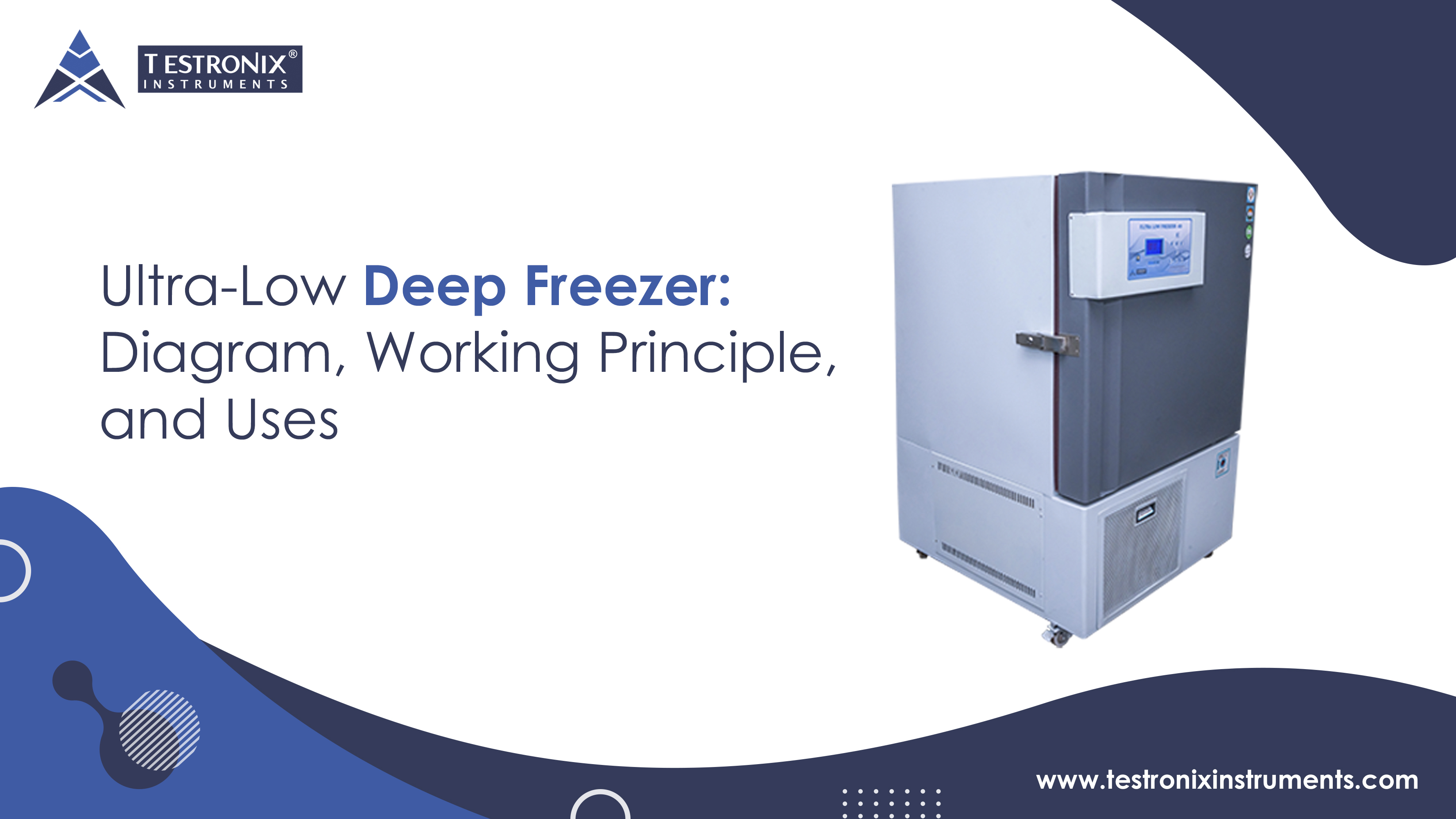Reviewed by Anurag Mishra (Sr. Technical Consultant)

Maintaining the integrity of sensitive biological samples and pharmaceuticals in research and clinical environments is a serious challenge. The challenge becomes more severe when ultra-low conditions are required.
Traditional refrigeration systems are unsuitable for storing materials that demand temperatures below -40°C. This creates the need for ultra-low deep freezers, also known as ultra-low temperature freezers (ULT). These specialized freezers offer a reliable solution for the long-term preservation of critical samples.
In this topic, we will explore the working principle of ultra-low temperature freezers, their key components, their schematic diagrams, and their necessary role in medical laboratories.
An ultra-low temperature freezer, also known as a ULT freezer, is a specialized freezer designed to maintain extremely low temperatures, typically ranging from -40°C to -86°C. With advanced insulation and precise temperature control, these freezers ensure the long-term stability of materials.

These ultra-low deep freezers are used in healthcare and scientific facilities where the extended storage of biological specimens is essential. They play a vital role in preserving the integrity of these substances. It also minimizes deterioration while enabling long-term storage without loss of quality.
The principle behind an ultra-low temperature (ULT) freezer is based on a refrigeration cycle that removes heat from the inside of the freezer to achieve very low temperatures, often as low as -80°C or lower.
Ultra-low temperature (ULT) freezers use an advanced cooling system to achieve and sustain ultra-low temperatures. Examining the operation of ultra-low temperature freezers can assist laboratory supervisors in choosing the most appropriate models for their requirements. This guarantees enduring performance.
Ultra-low temperature freezers attain and preserve deep-freeze levels, particularly below -80°C, through the use of advanced refrigeration technology and effective insulation. They particularly utilize a cascade refrigeration system that operates using dual refrigeration loops for attaining and preserving the required temperature.
Let’s take a closer look at the deep freezer working process:
The freezer uses a special cooling system that can operate in two ways. One way is with a single, strong compressor that does all the cooling. The other way is called the “cascade system”, which uses two compressors. In this system, the first compressor cools down part of the second one, helping it get even colder.
The evaporator helps pull heat out of the freezer. This is done by allowing the refrigerant inside the freezer to absorb the heat and carry it away. To make this happen effectively, metal plates or coils are used to help transfer the heat, making the cooling process work better.
ULT freezers use special cooling fluids, called refrigerants, to get cold. Common ones like propane and ethane are used because they save energy, but they catch fire easily. Other refrigerants like nitrogen and methane are also used depending on the freezer’s purpose and how safe they need to be.

Ultra-low deep freezer diagram highlights key internal and external components. These components are essential for maintaining the stable, ultra-low temperatures needed in medical and research laboratories. Here are the components of the ultra-low deep freezer diagram:
An ultra-low deep freezer is used to store sensitive materials such as biological samples, vaccines, and chemicals at a very low temperature. It is used to maintain the integrity of materials, avoid degradation, and ensure their long-term life.
One major application of an ultra-low deep freezer is the long-term preservation of biological samples. These include blood, plasma, tissues, DNA, and RNA, for use in medical research, diagnostics, and clinical studies. Deep freezers are commonly used in research, medical, and scientific settings, where maintaining the stability of samples over time is critical.
Due to their ability to reach temperatures as low as -80°C, ultra-low deep freezers play a vital role in laboratories and biobanks. They support safe storage, regulatory compliance, and consistent performance in handling valuable experimental or clinical samples.
To preserve temperature-sensitive biological materials such as plasma, blood, tissue samples, DNA, RNA, and vaccines.
Important for storing samples needed for diagnostic testing, research studies, and clinical trials.
By maintaining ultra-low temperatures, prevent degradation and bacterial growth, thus supporting accurate test results and reliable scientific results in medical research and patient care.
Additionally, ultra-low deep freezers are equipped with advanced monitoring and alarm systems that help ensure consistent temperature control and provide alerts in case of malfunctions, thereby safeguarding valuable and irreplaceable samples.
The temperature range of ultra-low freezers typically falls between -40°C to -86°C. Most commonly, they operate around -80°C, which is perfect for the long-term storage of sensitive biological samples.
The lowest safe freezer temperature for general laboratory and medical use is -86°C. This temperature is commonly used in ultra-low temperature freezers and is considered safe for long-term storage.
Ultra-deep freezers are mainly of two types: upright and chest models. They differ in design and accessibility, but both maintain ultra-low temperatures essential for preserving sensitive biological materials.
ULT Freezers utilize particular refrigerants to achieve ultra-low temperatures. Hydrocarbon refrigerants such as ethane and propane are used for their energy efficiency.
The particular lifespan of ultra-low freezers is typically 12-15 years. Carefully maintaining your ULT freezer will increase its useful life, minimize temperature fluctuations, and minimize energy consumption.
ULT freezers consume high energy. It often uses harmful refrigerants, contributing to greenhouse gas emissions and environmental degradation over time.